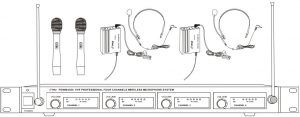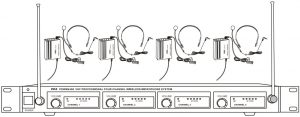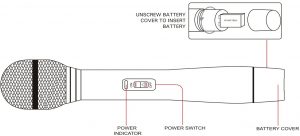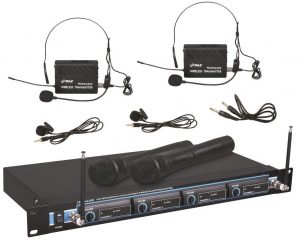PYLE Vhf Wireless Microphone System User Manual
VHF WIRELESS SYSTEM
OPERATION MANUAL
Please read through these operating instructions so you will know how to operate your model properly. After you have finished reading the instructions, put them away in a safe place for future reference.
PRECAUTIONS
- Avoid expose of the system to rain or moisture.
- No user-serviceable parts inside the system. Refer all servicing to qualified Technician only.
- Handle the wireless system carefully, dropping or other shocks may cause failure.
- Avoid using the system where it may be subjected to heat, such as direct sunlight near radiators or other heat sources.
- Should any liquid be spilt on the arrangement, stop using it immediately. It may be possible to dry the system, but you should have it checked by a qualified technician before using it again.
- Take upkeep with the main power transcriber and lead.If damaged in any way,do not use the system and refer to a qualified technician for repair.
- Only use the system with the supply components. Do not attempt to use with any other main power provision adapter.
- If the wireless system is not going to be used for a while, remove the battery to prevent leak. In the event of electrolyte leak interior the battery compartment, carefully remove the leakage with a damp material. Take care not to get battery electrolyte in contact lens with your skin, however if it does, washables your hands under a running strike. If electrolyte comes into contact with your heart,seek medical advice immediately.
- Only replace the battery with the same or an equivalent type.
- Please dispose of old batteries in an environmentally friendly manner in accordance with the relevant legislation.
- Do not use and solvents to clean any part of the wireless system.
SYSTEM DIAGRAM
PDWM4300
PDWM4400
HAND-HELD MICROPHONE:

OPERATION
- Unscrew the battery cover at the end of microphone, put 9V battery into compartment with correct polarities, then close the cover.
- Move “ON/OFF” switch to “ON” position, “PWR” indicator will light for one second and then go off. This indicates correct operation.If it doesn’t turn ON, please check the battery voltage or polarities. If the “PWR” indicator lights red, this indicates the battery power is low. Please replace with a fresh battery.
BODY PACK TRANSMITTER

OPERATION
- Open the battery cover to install 9V battery (check polarities). Move the power switch to ON position. The power Indicator will be green to indicate normal operation. If the LOW BAT indicator turns red, replace with a fresh battery promptly.
- Before operation, please confirm that the frequency of transmitter is same as the frequency of receiver. Plug the 3.5mm headset mic connector to screw-lock socket of transmitter. Move the audio switch to ON position. The MUTE switch cuts off the audio outputwithout shutting off the transmitter.
- ATTENUATlON is for volume adjustment. Move it to 0dB position to get normal volume output. Move to -20dB position to reduce distortion and avoid feedback.
- If the system will not be used for a long time, please switch OFF the transmitter to avoid power consumption.
RECEIVER
FRONT PANEL

- Power Indicator
- Power Switch
- Antenna
- CH-1 RF Signal Indicator
- CH-1 AF Indicator
- CH-2 RF Signal Indicator
- CH-2 AF Indicator
- CH-3 RF Signal Indicator
- CH-3 AF Indicator
- CH-4 RF Signal Indicator
- CH-4AF Indicator
- CH-1Volume Control
- CH-2 Volume Control
- CH-3 Volume Control
- CH-4 Volume Control
- Rack Mounts
OPERATION
Attach the two antennas and extend them vertically. Switch on the receiver.The red power indicator will come on. Switch on the transmitter. The red indicator RF/Channel1, RF/Channel2, RF/Channel3, RF/Channel4 will come on to indicate signal reception.The green AF LEVEL meters indicate the audio level. Adjust the volume of receiver, transmitters and amplifier. Please switch off the receiver, transmitters and amplifier when the wireless microphone system is not being used.
REAR PANEL
- 17. Balanced Output Jack
- 18. Mix output Jack
- 19. Individual Output Jack
- 20. DC Power IN
SQUELCH
The squelch control on the rear of the receiver is preset at the factory. If you must use the system in an area with considerable RF interference and there is some noise from the receiver when your transmitter is off, you can adjust the squelch control so that the system will receive the signal from your transmitter only but squelch or eliminate the unwanted background RF noise. This adjustment can cause reduction in useable range of the wireless transmitter, so set the control to the lowest position that reliablely mutes the unwanted RF signals.
Note that switching the microphone on and off can cause interference that will be heard if the microphone volume level of the amplifier system is still set high.
INSTALLATION
Using the supplied audio cable, connect from the MIXED jack socket to the “MIC IN” / “LINE IN” socket on amplifier. Alternatively, you can connect an optional XLR cable from the “XLR MIXED” socket on the receiver to a professional mixer. Connect the mains power adaptor from “DC 15V” jack to a suitable mains power socket.Installation Location:At least 3ft. above ground levelAt Least 3 ft. away from wall

TROUBLESHOOTING
|
The on air indicator does not light up |
The wireless microphone is not turned ON. | Turn on the wireless microphone |
| The microphone receiver is not turned ON. | Turn ON the microphone receiver and the connected audio equipment | |
| The microphone receiver is not connected properly | Turn on the microphone receiver and the connected audio equipment | |
|
No sound |
The battery in the wireless microphone is weak. | Replace the battery |
| The microphone receiver is not turned on. | Turn on the microphone receiver and the connected audio equipment. | |
| The connected audio equipment is not turned on. | Turn on the audio equipment. | |
| The speakers/headphones are not connected to the audio equipment | Connect the speakers/headphones | |
|
The sound is distorted |
The battery in the wireless microphone is weak | Replace the battery |
| The AUDIO OUT on the receiver is not set correctly. | Adjust the volume controls. | |
|
A howling noise heard from the speakers. |
The distance between the wireless microphone and speakers are too close. | Move the wireless microphone away from the speakers or change the direction of the microphone. |
| The battery in the wireless microphone is weak | Replace the battery |
Specifications
- Overall System
Oscillation Mode
Quartz Controlled
Carrier Frequency Range
VHF 174-216MHz
Stability
±0.005%
Max Deviation
±56KHz with level limiting
Dynamic Range
>100dB
S/N Ratio
≥80db
T.H.D
≤0.5%
Squelch
“Pilotone & Noise Lock” dual squelch circuit
Frequency Range:
Up to 240 Feet
- Receiver
Sensitivity
6dBµ V at S/N>90dB
Image Rejection
>60dB
Stability
>80dB
Audio Output
-12dB/600ohms unbalanced and balanced
Power Supply
15VDC/0.5A
Dimensions (m/m)
16.5×8.2×1.8 inch
- Transmitter
Mike Capsule
Dynamic Microphone (Handheld mic) Condenser Microphone (Headset mic/clip-on mic)
Antenna
Built-in Housing (Handheld Transmitter) External (Belt pack Transmitter)
RF Output
<-40dB
Spurious
<-40dB
Battery
one 9V Battery
References
[xyz-ips snippet=”download-snippet”]



